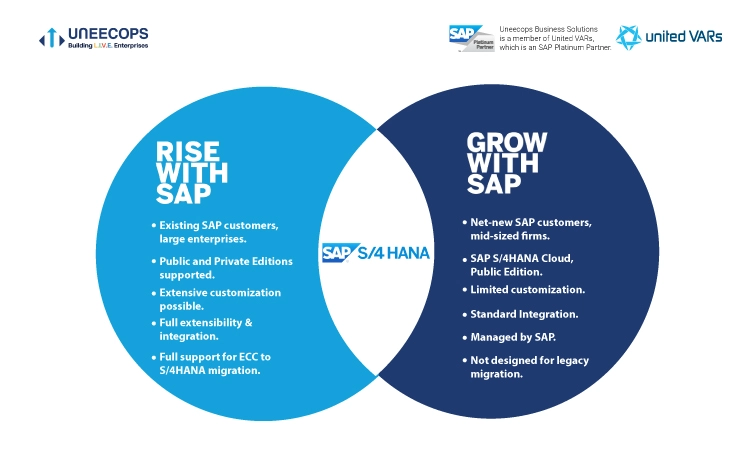Both ERP (enterprise resource planning) are software solutions by SAP. Both known for their performance and ability to streamline major business operations.
That’s both, SAP ECC and SAP S/4HANA.
So, what distinguishes them? While SAP ECC has been a long-standing and trusted ERP system, SAP introduced SAP S/4HANA in 2015 as the next-generation ERP suite.
With SAP’s announcement to discontinue support for SAP ECC by 2027, organizations are faced with the imperative to migrate to SAP S/4HANA. In this article, we will delve into the key differences between these two systems, equipping you with the essential knowledge to navigate the transition successfully.
Here’s a comparison table highlighting the key differences between SAP ECC and SAP S/4HANA:
| Feature/Aspect | SAP ECC | SAP S/4HANA |
| The Meaning | SAP ERP Central Component or SAP ECC is a modular, customizable ERP. It can be configured as per business-specific operations, including accounts to inventory to logistics. | It is SAP’s newest generation of ERP software solution that uses advanced technologies, such as AI and ML to unify core operations. It helps analyze huge volumes/amounts of data in real-time. |
| Default Account-Based CO-PA | Default option is costing-based CO-PA (CO-Profitability Analysis) | Default is account-based CO-PA, and option to run costing-based CO-PA |
| FI (Finance) and CO (Controlling) | Can manage with both | Simpler system. Part of one, single module in ACDOCA, the Universal Journal. This means period-end ledger closings are automated in real-time. |
| Integrated Business Partners | Customers and vendors are different data variables/objects | Customers and vendors are unified as master data variable/object and are called business partners. |
| Real-time MRP (material requirements planning) | Wait until non-peak hours and run a batch job | Run MRP in real-time |
| Mandatory Material Ledger (ML) | Optional | Mandatory (part of ACDOCA) |
| Database | Relational Database (e.g., Oracle, MS SQL) | In-Memory Database (SAP HANA) |
| User Experience | SAP GUI | SAP Fiori UX |
| Architecture | Two-tier architecture | Three-tier architecture |
| Data Model | Row-based | Columnar |
| Real-time Analytics | Limited real-time analytics capabilities | Advanced real-time analytics capabilities |
| Reporting and Analytics | Traditional reporting tools | Embedded analytics with SAP Analytics Cloud |
| Simplification | Complex business processes | Simplified and streamlined processes |
| Deployment Options | On-premises | On-premises, Cloud, Hybrid |
| Customizations | Extensive customizations | Limited customizations, enhanced configuration |
| System Conversion | Requires system conversion for migration | Direct migration |
| Simplified Data Model | N/A | SAP S/4HANA data model |
| Industry-Specific Solutions | Limited industry-specific solutions | Enhanced industry-specific solutions |
| Machine Learning and AI Integration | Limited integration | Native integration with machine learning and AI capabilities |
| Internet of Things (IoT) Integration | Limited IoT integration | Native IoT integration capabilities |
| Integration with Other Systems and Apps | Traditional integration approaches | Open APIs for seamless integration |
| Master Data Management | Limited master data management | Centralized master data management |
| Performance Optimization | Limited performance optimization | Enhanced performance optimization |
| System Maintenance and Patching | Manual maintenance and patching | Automated maintenance and patching |
| Support and Future Development | Extended support until 2027 | Long-term support and innovation roadmap |
The major difference
SAP S/4HANA revolutionizes features and processes inherited from SAP ECC, resulting in cost reductions and enhanced business efficiency. This transformative shift entails a blend of feature modifications, replacements, and amalgamations, aimed at delivering optimal performance. As a result, some familiar functionalities have undergone changes, while others have been superseded or merged into innovative features that align with the evolving business landscape.
So, what are the latest features that make SAP S/4 HANA manage your data more effectively? Let’s find out.
Advanced Features in SAP S/4HANA
The SAP HANA Database
SAP S/4HANA leverages the SAP HANA database for faster and more efficient operations by reading data from main memory, utilizing column-based tables, eliminating aggregates and indexes, and combining OLTP and OLAP tables.
Revenue Accounting and Reporting (RAR)
SAP S/4HANA’s has a new Revenue Accounting and Reporting (RAR) module, that replaces SD Revenue Recognition in SAP ECC, offering optimized contract management features and easy revenue recognition that is also compliant with IFRS 15.
SAP Fiori User Interface
SAP S/4HANA introduces SAP Fiori, a modern and intuitive user interface that enhances productivity, accelerates onboarding, and delivers a consistent user experience across devices, supporting custom enterprise app development.
Advanced ATP
SAP S/4HANA brings advanced ATP (aATP) with automated capabilities like releasing delivery items, checking availability of stock in alternative plants, and performing mass-level availability checks.
Global Trade Services
S/4HANA introduces Global Trade Services (GTS) integration, replacing SAP ECC’s foreign trade functions and automating processes such as checking of embargo, license checks, and declarations of import/export.
FSCM Credit Management
In SAP S/4HANA, credit management falls within financial supply chain management (FSCM), offering automated workflows for approval of credit limit, risk scoring, and direct interface with third-party credit agencies.
Extended Warehouse Management
SAP S/4HANA replaces Warehouse Management (WM) with Extended Warehouse Management (EWM), enabling efficient management of complex warehouse processes, including labor management and goods distribution.
ACDOCA: The Universal Journal
SAP S/4HANA unifies data modules into ACDOCA, the Universal Journal, eliminating aggregate and index tables, reducing data footprint, and improving system efficiency.
MATDOC: Inventory Management
SAP S/4HANA replaces multiple tables with MATDOC, enhancing inventory management by eliminating redundancy, improving stock reporting, and streamlining material document storage.
While those were the technicalities, what is the overall business benefit of switching to SAP S/4 HANA? Let us discover.
Benefits of Opting for SAP S/4HANA
According to a recent study conducted by IDC, organizations leveraging SAP HANA to drive business growth and operational efficiencies experienced an impressive average return on investment (ROI) of 679% over a span of five years. This remarkable achievement translated into substantial revenue gains of $34.1 million per organization. The study highlights the significant impact and value that SAP S/4 HANA brings to businesses in terms of financial outcomes and overall success.
Advantages of Choosing SAP S/4HANA
- Simplified data models
- Easy integration with SAP ECC, SAP B1 and other SAP products
- Operates in cloud, so has lower operational and ownership costs
- Automation and AI improve productivity and performance
- Faster, smarter, data-backed decision-making
- Scalability and flexibility to adapt resources to evolving needs
- Faster time to value with preconfigured environments and templates
- Reduced IT complexity by outsourcing infrastructure management
- Enhanced accessibility and collaboration from any device, anywhere
- Cost savings through pay-as-you-go pricing and eliminating hardware investments
- Continuous innovation and upgrades delivered by the cloud provider
- Improved data security and compliance with robust cloud security measures
Understanding the key differences between SAP releases highlights the benefits of transitioning to SAP S/4HANA and emphasizes the importance of a smooth migration process. As SAP plans to end support for older versions by 2027, S/4HANA transformation becomes a necessity. The advantages include an enhanced user experience, improved performance, and reduced total cost of ownership.
Setting the Stage for SAP S/4HANA with Enterprise Architecture
To pave the way for S/4HANA, it’s crucial to develop a digital transformation roadmap and consider partnering with a managed services provider experienced in SAP and various cloud vendors. This can streamline planning, development, minimize costs, and mitigate disruptions to your business.
Uneecops has been an industry leader in SAP consultation, migration and implementation services. Uneecops is a member of United VARs, which is an SAP Platinum Partner. We specialize in SAP S/4 HANA deployment end-to-end. Let us begin with a discovery call to understand your SAP environment and the possibilities of seamlessly migrating to SAP S/4 HANA. Let’s 1,2,3 S/4 HANA!







